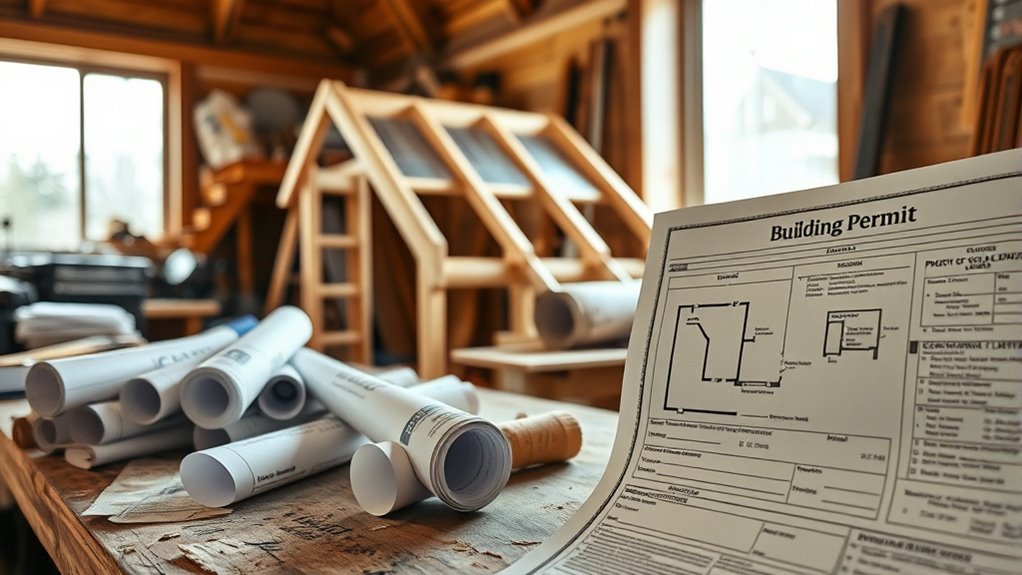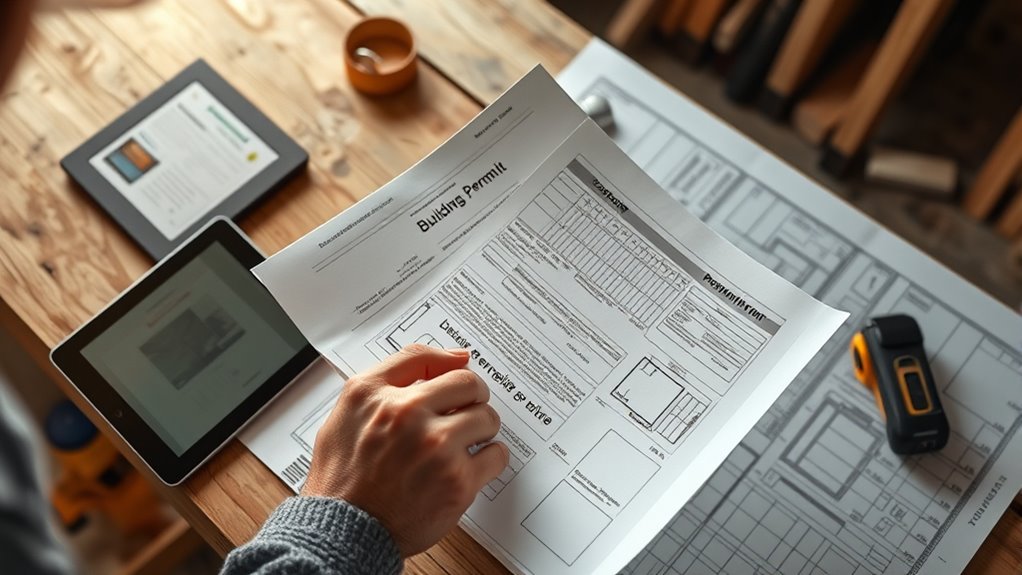When tackling DIY home projects, it’s essential to understand building permits. These permits ensure your work follows local safety and zoning rules, helping you avoid fines, delays, or needing to undo your work. You’ll need to submit detailed plans and undergo inspections during construction. Skipping permits can cause legal issues and extra costs. If you want to make certain your project stays on track and compliant, more helpful tips are just ahead.
Key Takeaways
- Building permits are essential for legal, safe property modifications, preventing fines and work undoing.
- Understand local zoning laws to ensure your project complies with community standards and land use rules.
- Gather detailed plans and submit applications with fees to the appropriate building department for approval.
- Obtain and display permits visibly; schedule inspections during construction to ensure code compliance.
- Skipping permits risks delays, fines, legal issues, and the need to undo or redo work, increasing overall costs.

If you’re planning a DIY project that involves any structural changes or additions to your property, obtaining the proper building permits is vital. Skipping this step can lead to legal complications, hefty fines, or even having to undo your work. Before diving into your project, you need to understand how zoning regulations and the permit application process work in your area. Zoning regulations are local laws that dictate what types of structures you can build and where. They help guarantee that your project complies with community standards, prevents conflicts with neighbors, and preserves neighborhood aesthetics. These rules vary by location, so it’s essential to check with your city or county planning department early on. They can provide specific information about setbacks, height restrictions, land use, and other zoning requirements relevant to your project.
The permit application process can seem intimidating at first, but breaking it down makes it manageable. Typically, you’ll start by gathering detailed plans and drawings of your project, including scale diagrams, materials, and construction methods. This documentation helps authorities understand what you intend to do and assess whether it complies with local codes. Next, you’ll submit your application to the relevant building department, often accompanied by a fee. Some jurisdictions allow online submissions, making it more convenient, but others might require in-person visits. Once submitted, your application will undergo review. During this review, officials verify that your project aligns with zoning regulations and building codes, ensuring safety and community standards are met.
Expect some back-and-forth during this process. You might need to revise your plans or provide additional information. Patience is key; the review times can vary based on workload and project complexity. Once approved, you’ll receive your building permit, which grants you legal authorization to proceed. Keep in mind that permits usually need to be posted visibly at your work site and may require inspections during different phases of construction. These inspections are vital to confirm that your work adheres to approved plans and code compliance. Additionally, awareness of building codes is essential, as they set the safety standards that your project must meet. Failing to secure necessary permits can result in delays, fines, or even having to dismantle completed work, so it’s worth the effort to follow the proper process from the start.
Frequently Asked Questions
How Long Does the Permit Approval Process Typically Take?
The permit processing time varies depending on your project and location, but typically, you can expect the approval timeline to take anywhere from a few days to several weeks. During this period, authorities review your plans and make certain compliance with local codes. To speed up the process, make sure your application is complete and accurate. Patience is key, as thorough review helps prevent delays or issues down the line.
Are There Any DIY Projects That Never Require Permits?
You might think some DIY projects are a free pass, but there’s no such thing as a one-size-fits-all answer. Certain small projects, like painting or minor landscaping, often fall under permit exemptions or project exemptions. However, always check local codes first—permitting rules vary widely. Even if a project seems simple, it’s better to be safe than sorry, so verify whether permits are needed before you start swinging hammers.
What Are the Consequences of Working Without a Permit?
If you work without a permit, you risk permit violations that can lead to serious legal penalties. Authorities may require you to undo or redo your work, which can be costly and time-consuming. You might also face fines or delays when selling your home, as permit violations often come up during inspections. Always check local regulations—they’re in place to protect you and guarantee your project meets safety standards.
Can I Apply for a Permit After Completing a Project?
You can typically apply for a permit after completing your project, but it depends on your local regulations. Your permit application might be approved post-project, allowing you to legally finalize your work. However, some jurisdictions require permits prior to starting. Check with your local building department to see if they accept post-project approval applications. Acting promptly ensures your project remains compliant and avoids potential fines or penalties.
Do Permit Requirements Vary Between Different Cities or Counties?
Nearly 80% of DIYers don’t realize permit requirements differ across cities and counties. You should know that local building codes influence these rules, so what’s permit-exempt in one area might require a permit in another. Always check with your local building department before starting a project, as permit exemptions vary, and neglecting this can lead to fines or needing to undo work later. Stay informed to avoid surprises!
Conclusion
Think of building permits as your guiding star in your DIY journey. They symbolize respect for the rules and your commitment to quality. By securing the proper permits, you’re not just following regulations—you’re anchoring your project in integrity and safety. Remember, each permit is a beacon that keeps your dreams grounded and your home protected. Embrace the process, and let it illuminate your path to a successful, proud achievement.
Alfons is the visionary leader and driving force behind Voyager Info’s success. As the Editor in Chief, he brings a wealth of experience and an unwavering passion for travel to the helm of our cruise-centric platform.
With a lifelong fascination for exploring new horizons, Alfons discovered his love for the ocean and cruising at a young age. From sailing across pristine Caribbean waters to embarking on daring expeditions to far-flung destinations, he has amassed a treasure trove of first-hand experiences in the world of cruising.











